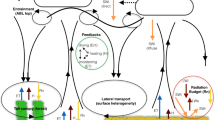Summary
Leaf temperatures were measured by means of an infrared radiometer. Sunlit leaves were as much as 20°C above air temperature. Shade leaves averaged 1.5°C below air temperature during the daytime. Quantitative calculations of the energy exchange for a leaf are made showing the distribution of energy into solar and thermal radiation, reradiation by the leaf, convection exchange, and transpiration. From the observed temperatures it is shown that transpiration must play a relatively strong role in reducing leaf temperatures, and that convection is a relatively inefficient process.
Zusammenfassung
Mit einem Infrarot-Radiometer wurden Blatttemperaturen gemessen. Sonnenbeschienene Blätter hatten bis zu 20°C höhere Temperaturen als die Luft. Die Temperatur von beschatteten Blättern blieb tagsüber um 1,5°C unter der Lufttemperatur. Es werden quantitative Berechnungen des Energieaustausches an einem Blatt durchgeführt und der Anteil von Sonnen- und Wärmestrahlung, Rückstrahlung des Blattes, konvektivem Austausch und Transpiration abgeleitet. An Hand der beobachteten Temperaturen wird gezeigt, daß der Transpiration ein verhältnismäßig großer Anteil an der Erniedrigung der Blattemperatur zukommt, während die Konvektion dabei verhältnismäßig unwirksam ist.
Résumé
On a mesuré la température de feuilles au moyen d'un radiomètre à rayons infra-rouges. Les feuilles exposées au soleil avaient alors des températures jusqu'à 20°C supérieures à celles de l'air. La température des feuilles placées à l'ombre est par contre restée de 1,5°C inférieure à celle de l'air. On en déduit alors par calcul l'échange d'énergie se produisant sur une feuille, la part des radiations solaire et calorifique, du rayonnement de la feuille, des échanges convectifs et de la transpiration. Au moyen des températures observées, on démontre qu'une part relativement importante de l'abaissement de la température des feuilles revient à la transpiration, alors que la convection est relativement inopérante dans ce cas.
Similar content being viewed by others
References
Stoll, A. M., andJ. D. Hardy: A Method for Measuring Radiant Temperatures of the Environment. J. Appl. Physiol.5, 117–124 (1952).
Gates, D. M.: Winter Thermal Radiation Studies in Yellowstone Park. Science134, 32–35 (1961).
Gates, D. M. andW. Tantraporn: The Reflectivity of Deciduous Trees and Herbaceous Plants in the Infrared to 25 Microns. Science115, 613–616 (1952).
Moss, R. A., andW. E. Loomis: Absorption Spectra of Leaves. I. The Visible Spectrum. Plant Physiol.27, 370–391 (1952).
Ansari, A. Q., andW. E. Loomis: Leaf Temperatures. Amer. J. Bot.46, 713–717 (1959).
Author information
Authors and Affiliations
Additional information
Dedicated to Dr.W. Mörikofer on the occasion of his 70th birthday.
With 9 Figures
Rights and permissions
About this article
Cite this article
Gates, D.M. Leaf temperature and energy exchange. Arch. Met. Geoph. Biokl. B. 12, 321–336 (1962). https://doi.org/10.1007/BF02315993
Issue Date:
DOI: https://doi.org/10.1007/BF02315993




